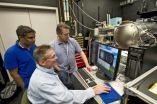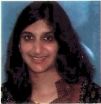(Press-News.org) NASA's next flagship mission — the James Webb Space Telescope — will carry the largest primary mirror ever deployed. This segmented behemoth will unfold to 21.3 feet in diameter once the observatory reaches its orbit in 2018.
A team of scientists at NASA's Goddard Space Flight Center in Greenbelt, Md., now is developing an instrument that would image and characterize planets beyond the solar system possibly from a high-altitude balloon has borrowed a page from the Webb telescope's playbook. It has created an infinitely smaller segmented mirror that currently measures less than a half-inch in diameter and promises to revolutionize space-based telescopes in the future.
The multiple mirror array (MMA), now being developed by the Berkeley, Calif.-based Iris AO, Inc., under a NASA Small Business Innovative Research grant, is one of the enabling technologies on the Visible Nulling Coronagraph (VNC), a hybrid instrument combining an interferometer with a coronagraph — in itself a first. In laboratory tests, the VNC has proven that it can detect, image, and characterize likely targets. "Nearly all the technologies are completed or are on track," said Principal Investigator Rick Lyon of NASA Goddard, who, with his colleague, Mark Clampin, began working on the VNC more than three years ago.
As a result of that progress, the team hopes to apply the technology to a balloon-borne instrument called the Big Balloon Exoplanet Nulling Interferometer (BigBENI), which Lyon believes could be ready for operations as early as 2016. Carried on a gondola attached to a high-altitude balloon, the VNC-equipped BigBENI would be able to suppress starlight and increase the contrast of Jupiter- and ultimately Earth-sized planets.
The science that BigBENI could perform is compelling, Lyon added. At 135,000 feet — the altitude at which NASA balloons fly — Lyon estimates he could detect and image at least eight science targets in less than five hours and an additional six in about 20 hours. "BigBENI offers a nearer-term way to image planets" and search for specific chemicals that might indicate the presence of life — a long-sought science goal.
Mirror Array Central to Capability
Such a capability is due in large part to the tiny mirrors, Lyon said. "MMA is a legacy of the Webb telescope," he added. "Segmented mirrors are the future, not only for traditional observing missions like Webb, but also for non-traditional uses, like the one we've developed for planet finding. No other coronagraph has segmented mirrors."
Under the VNC/BigBENI concept — whose development NASA currently supports through several technology-development programs — starlight collected by a primary mirror or telescope travels down the instrument's optical path to the first of two beamsplitters within each arm of the VNC interferometer. The MMA is located in only one arm. A second beamsplitter recombines the beams into two output paths known as the "bright" and "dark" channels. The starlight passes to the bright and the planet light to the dark.
Because MMA is a mirror image of the telescope, it can see wavefront and amplitude errors caused by vibration, dust, and turbulence that prevent the light from being perfectly focused as it's collected. The MMA not only senses those errors, but also corrects them.
Algorithms that Lyon developed calculate errors in the telescope's wavefront and instruct MMA's 169 tiny nano-size segments — each measuring the width of three human hairs and perched atop tiny finger-like devices — to piston, tip, and tilt up to thousands of times per second to precisely correct the distortions and then cancel the starlight in the dark channel. A second technology, the spatial filter array, passively acts in concert with the MMA to further correct both amplitude and wavefront errors.
Combined, these technologies allow the mirror array to create an internal coronagraph to suppress starlight and increase the contrast of the circumstellar region surrounding a star, thereby allowing scientists to detect planets and dust disks. BigBENI's mirror array would contain 313 segments, Lyon said.
Applications Abound
While unique in its application as a coronagraph, MMA and its associated wavefront-sensing-and-control technologies, hold great promise for other applications, including medical imaging, LASIK eye surgery, and even military gun sights, Lyon said. But for NASA, the benefit lies in being able to fly less expensive telescopes.
"Ultimately with this technology, you can get away with a low-cost, low-risk primary mirror," Lyon said. In contrast, Webb's much larger segmented mirror was expensive to build. Technicians carefully constructed the mirror segments to an exact optical prescription and then mounted them on a mechanism that positions each to perfect alignment, much like the tiny fingers on MMA.
To assure a perfect focus, however, the Webb telescope will first image a target. After ground controllers have analyzed the image with multiple algorithms, they then can send commands to tweak the mirrors' alignment. This compares with MMA's ability to perform up to thousands of wavefront calculations per second, position the mirror segments, and then maintain a tight alignment — all from onboard the instrument.
"The idea is can we come up with something that is up to hundreds of times more precise than the Webb telescope's wavefront control? I think we can. We're doing it now in a standard lab. If you can do wavefront sensing and control fast enough, which we've proven, you can get away with a not-so-great telescope," Lyon said.
INFORMATION:
For other technology news, visit:
http://gsfctechnology.gsfc.nasa.gov
For more information on the James Webb Space Telescope, visit:
www.jwst.nasa.gov
Tiny planet-finding mirrors borrow from Webb Telescope playbook
2012-05-28
ELSE PRESS RELEASES FROM THIS DATE:
Scientists evaluate different antimicrobial metals for use in water filters
2012-05-28
Porous ceramic water filters are often coated with colloidal silver, which prevents the growth of microbes trapped in the micro- and nano-scale pores of the filter. Other metals such as copper and zinc have also been shown to exhibit anti-microbial activity. Researchers from Princeton University in New Jersey used atomic force microscopy (AFM) measurements to study the adhesion interaction between Escherichia coli (E. coli) bacteria and colloidal silver, silver nanoparticles, and copper nanoparticles, as well as the interactions of the bacteria and the three different types ...
'Personality genes' may help account for longevity
2012-05-28
VIDEO:
Nir Barzilai, M.D., discusses his new research on how personality traits like being outgoing, optimistic, easygoing, and enjoying laughter as well as staying engaged in activities may also be part...
Click here for more information.
May 24, 2012 – (BRONX, NY) – "It's in their genes" is a common refrain from scientists when asked about factors that allow centenarians to reach age 100 and beyond. Up until now, research has focused on genetic variations that offer a physiological ...
Asteroid nudged by sunlight: Most precise measurement of Yarkovsky effect
2012-05-28
Scientists on NASA's asteroid sample return mission, Origins, Spectral Interpretation, Resource Identification, Security, Regolith Explorer (OSIRIS-REx), have measured the orbit of their destination asteroid, 1999 RQ36, with such accuracy they were able to directly measure the drift resulting from a subtle but important force called the Yarkovsky effect – the slight push created when the asteroid absorbs sunlight and re-emits that energy as heat.
"The new orbit for the half-kilometer (one-third mile) diameter 1999 RQ36 is the most precise asteroid orbit ever obtained," ...
Routine care for Crohn's disease in children should include measurement of bone age
2012-05-28
Measuring bone age should be a standard practice of care for pediatric patients with Crohn's disease, in order to properly interpret growth status and improve treatment, according to a new study from the UCSF Benioff Children's Hospital.
"Not only is bone age helpful in predicting a child's remaining growth potential, our study demonstrates that bone age is necessary to correctly interpret a patient's growth status in pediatric Crohn's disease," said lead study researcher Neera Gupta, MD, MAS, a pediatric gastroenterologist at the UCSF Benioff Children's Hospital.
Impaired ...
Ben-Gurion U. researchers successfully test solar desalination system for arid land agriculture
2012-05-28
NEW YORK, May 25, 2012 – Ben-Gurion University of the Negev (BGU) researchers have created a man-made oasis in the desert with the successful application of a solar-powered desalination system that provides water for irrigation in arid regions. The project was made possible with support from American Associates, Ben-Gurion University of the Negev (AABGU).
The solar-powered system uses nanofiltration membranes to treat the local brackish (saline) water, resulting in high-quality desalinated irrigation water. The results of the Josefowitz Oasis Project indicate that irrigation ...
OSIRIS-REx scientists measure Yarkovsky effect
2012-05-28
Scientists with the University of Arizona-led asteroid sample return mission OSIRIS-REx have measured the orbit of their destination asteroid, 1999 RQ36, with such accuracy they were able to directly determine the drift resulting from a subtle but important force called the Yarkovsky effect – the slight push created when the asteroid absorbs sunlight and re-emits that energy as heat.
The new orbit for the half-kilometer (one-third mile) diameter 1999 RQ36 is the most precise asteroid orbit ever obtained, OSIRIS-REx team member Steven Chesley of the NASA Jet Propulsion ...
Cedars-Sinai physician definitively links irritable bowel syndrome and bacteria in gut
2012-05-28
LOS ANGELES (May 25, 2012) – An overgrowth of bacteria in the gut has been definitively linked to Irritable Bowel Syndrome in the results of a new Cedars-Sinai study which used cultures from the small intestine. This is the first study to use this "gold standard" method of connecting bacteria to the cause of the disease that affects an estimated 30 million people in the United States.
Previous studies have indicated that bacteria play a role in the disease, including breath tests detecting methane – a byproduct of bacterial fermentation in the gut. This study was the ...
From stem cell to brain cell – new technique mimics the brain
2012-05-28
A new technique that converts stem cells into brain cells has been developed by researchers at Lund University. The method is simpler, quicker and safer than previous research has shown and opens the doors to a shorter route to clinical cell transplants.
By adding two different molecules, the researchers have discovered a surprisingly simple way of starting the stem cells' journey to become finished brain cells. The process mimics the brain's natural development by releasing signals that are part of the normal development process. Experiments in animal models have shown ...
Like curry? New biological role identified for compound used in ancient medicine
2012-05-28
CORVALLIS, Ore. – Scientists have just identified a new reason why some curry dishes, made with spices humans have used for thousands of years, might be good for you.
New research at Oregon State University has discovered that curcumin, a compound found in the cooking spice turmeric, can cause a modest but measurable increase in levels of a protein that's known to be important in the "innate" immune system, helping to prevent infection in humans and other animals.
This cathelicidin antimicrobial peptide, or CAMP, is part of what helps our immune system fight off various ...
Phone contact with nurses linked with better outcomes for women with gestational diabetes
2012-05-28
OAKLAND, Calif., May 25, 2012 – Among women with gestational diabetes mellitus, referral to a telephone-based nurse management program was associated with lower risk of high baby birth weight and increased postpartum glucose testing, according to Kaiser Permanente researchers.
Investigators for the Kaiser Permanente Northern California Division of Research examined the associations between referral to telephone-based nurse consultation and outcomes in 12 Kaiser Permanente medical centers with variation in the percent of patients referred to telephonic nurse management. ...



